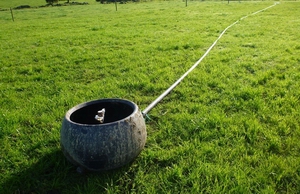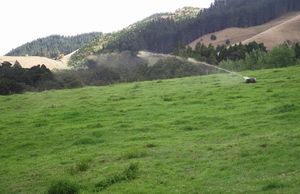Land application
The permitted activity criteria – outlined in the Proposed Regional Plan for Northland, Rule C.6.3 – must be complied with when applying wastewater to land.
System selection
Selecting and designing a system to achieve effective land application is a challenge in Northland, due to:
- Heavy soil types;
- High rainfall (soils can be saturated for up to five months);
- Rolling/steep land contours;
- Intermittently flowing drains and streams;
- High water tables on low-lying land; and
- Subsurface drains.
Correct design and integration with planned or existing storage ponds, pumps, pipelines and irrigators is crucial, along with routine maintenance and management of the overall system.
Choosing an irrigator
When buying an irrigator or upgrading your system, it is important to spend time planning to ensure the irrigator is suited to the land, pump and hose sizes. Avoid buying irrigators "off the rack" without investigating what infrastructure it is specified to work with.
It is recommended that you consult a suitably qualified, experienced and reputable professional to assist with the design and installation of the system.
Low application rate irrigation


Low application-rate sprinklers and some modern travelling irrigators can cover large areas at low application rates.
Traditionally, low application rate sprinklers have created management problems due to small diameter nozzles repeatedly blocking. However, a range of nozzle sizes for low application-rate sprinklers are now available. At 20psi, a 9mm nozzle can spread as much as 3700 litres/hour over 850m2 at an application rate of 4-5mm/hour.
Wastewater volumes and areas of application increase with pump capacity and pressure. The PODS irrigation systems can operate at up to 100psi.
A number of Northland farmers are operating sprinklers from ponds using gravity rather than a pump, with good results.
Routine maintenance
Land application systems require routine maintenance and good management practices to prevent equipment failure and/or non-compliance with regional rules.
Common issues include:
- Pump suction – blocked by excessive solids (or other matter);
- Blocked irrigator or sprinkler nozzles;
- Leaks or breaks in the mains or drag hose;
- Coupling or hydrant failure;
- Human error;
- Travelling irrigators operating at too low a travel speed (or stalling in one place);
- Irrigators not moved frequently enough; and
- Irrigating too close to drains or streams.
Safety measures
Simple electronic systems, which can save damage to the system and reduce the risk of non-compliance, should be installed.
The council recommends that, at a minimum, land application systems are fitted with electronic controls, which will stop the pump in the event of:
- Excessive high pressure;
- Low pressure; and
- Low or no flow.
